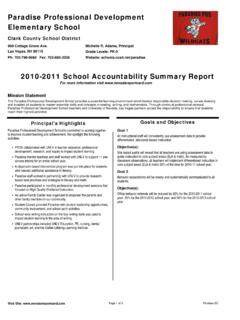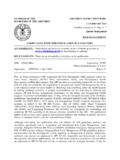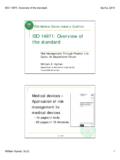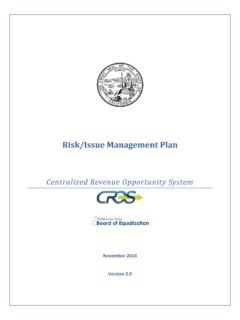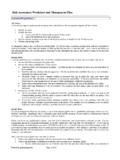Transcription of RISK MANAGEMENT PLAN - Clark County School District
1 RISK MANAGEMENT plan Clark County School District Report date: June 28, 2013 Objectives: Risk Identification Risk Quantification Risk plan and Process RISK MANAGEMENT plan Transforming K12 Education 2012 Infinite Campus, Inc. All Rights Reserved. 2 RISK MANAGEMENT plan Transforming K12 Education 2012 Infinite Campus, Inc. All Rights Reserved. 3 Table of Contents Document Change Control .. 4 Definition .. 4 Objectives .. 5 Definitions .. 5 Responsibilities .. 5 Overview .. 5 Methodology 6 Key Risk MANAGEMENT Activities 6 Initial Risk Identification .. 7 Risk Rating Reference 8 Risk Exposure Reference 8 Risk Response Planning .. 9 Risk Response Strategies .. 9 Avoidance 9 Mitigation 9 Acceptance 10 Transference 10 Risk Monitoring and Control.
2 11 Appendix A - Potential Risk Checklist .. 12 Signature Page .. 13 RISK MANAGEMENT plan Transforming K12 Education 2012 Infinite Campus, Inc. All Rights Reserved. 4 Document Change Control The following is the control for revisions to this document. Version Date of Issue Author(s) Brief Description of Change 20 Apr 2013 Kelvin Beck Original document template 14 May 2013 Kelvin Beck Incorporated requested modifications from CCSD PM(name change on page 6, risk assessment date on page 7, paragraph update on page11 to include weekly risk reviews) Revision 1 6/19/2013 Greg Halopoff, Kim Boyle Final review and edits Definition The following are definitions of terms, abbreviations and acronyms used in this document.
3 Term Definition CCSD Clark County School District EBT Employee Business Training ICDE Infinite Campus District Edition SIS Student Information System SME Subject Matter Experts RISK MANAGEMENT plan Transforming K12 Education 2012 Infinite Campus, Inc. All Rights Reserved. 5 Objectives The purpose of the risk MANAGEMENT plan is to identify, analyze, plan , track, control, and communicate all likely and potential risks to a project. Effective project risk MANAGEMENT will: Help focus attention on where we can have the most effect and where efforts are most beneficial Avoid crisis MANAGEMENT by proactive control and MANAGEMENT of identified project risks Maximize the likelihood of success of the project Definitions Risk the possibility of suffering harm and/or loss Risk Categories where risks come from Risk probability likelihood of a risk occurring Risk Consequence the amount at stake, or impact if a risk occurs Risk Exposure a measure that establishes the seriousness of a risk by combining the impact and probability of the risk, should it materialize Risk indicators (or triggers)
4 Early warning signs for a risk that trigger the implementation of the planned strategy Risk response strategies: o Avoidance Eliminate the risk by eliminating the cause. o Mitigation Reduce the probability or consequence of a risk to an acceptable level. o Acceptance Do nothing and decide that if it happens, it happens." o Transference Make another party responsible for the risk ( insurance, warranties, outsourcing, etc.). Responsibilities The Project Steering Committee is jointly responsible for managing project risks with input from both CCSD and Infinite Campus Project Sponsors and other resources. All project team members are responsible for identifying, tracking and controlling risks . Once identified, they are then managed through the risk MANAGEMENT plan .
5 Overview The risk MANAGEMENT process is fundamental to the successful delivery of the project. It ensures that risks within the project environment are identified, documented, prioritized and mitigated wherever possible. For the purposes of this project, risks are defined as any event that is likely to adversely affect the timeline, cost or ability of the project to produce the required deliverables for successful system implementation . All projects have some level of risk associated with them. However, risk and opportunity go hand in hand and success cannot be achieved without some degree of risk. The key is in knowing what the risks are and in balancing the potentially negative consequences of risk against the potential benefits of opportunity.
6 Projects that devote even a small amount of attention, time, and effort to managing risks have dramatically improved chances of succeeding as planned. RISK MANAGEMENT plan Transforming K12 Education 2012 Infinite Campus, Inc. All Rights Reserved. 6 IdentifyAnalyzePlanControlCOMMUNICATET rackMethodology A straightforward method that includes identifying and categorizing project risks (Identify) will be used for the CCSD Implementation Project, assessing and prioritizing the risks (Analyze) so they are manageable, developing a response strategy and assigning responsibility ( plan ), tracking the risks by reviewing them at key project milestones (Track), implementing the defined response strategies as required (Control) and most importantly, Communicating the risks and strategies on an ongoing basis throughout the life of the project.
7 Key Risk MANAGEMENT Activities Activity How Purpose Identify risks Create a list of project risks and group them into categories; gather risks from stakeholders using brainstorming, predefined lists, and/or completion of risk identification questionnaires Make known project risks explicit before they become problems; helps to set expectations and provide a vehicle for reaching consensus unknown risks cannot be managed Analyze risks Determine the probability and consequence of risks listed and calculate the risk exposure Transforms the risk data into decision making information plan Determine desired risk strategies and actions, and assign responsibility Translates the risk information into strategies and mitigation actions Track Review and re-examine risks when project situation changes or key milestones are achieved Monitors risk indicators and mitigation actions Control Implement planned actions when risk indicators manifest.
8 Determine mitigation effectiveness for continuous improvement Corrects and ensures implementation of mitigation actions as required Communicate Discuss and review project risks and plans in project status, or other scheduled meetings, when the project situation changes or key milestones are achieved Enables sharing of critical information throughout the project RISK MANAGEMENT plan Transforming K12 Education 2012 Infinite Campus, Inc. All Rights Reserved. 7 Initial Risk Identification The Project Steering Committee will conduct an initial risk identification meeting to begin the process of looking at project risk. 1. Identify various risk categories , environment, technical, data conversion, resources, etc.
9 2. Create a comprehensive list of any and all project risk (Appendix A: Potential Risk Checklist). 3. As each risk is validated, perform a risk evaluation: a. Assess the risk or risk category as appropriate, and assign a value for probability and impact using the Risk Rating Reference table below. b. Determine risk exposure and reach consensus on which risks will require the development of a risk response strategy. c. Define the appropriate risk response strategy and action to be implemented as required. As a general guide, risk response strategies and plans should be developed for all risks that represent High risk exposure. Careful consideration should also be given to risks with Medium risk exposure and it is a good idea to at least identify the risk response strategy (avoid, mitigate, accept, transfer - described in the sections below) and triggers to indicate when full-blown risk plans should be developed.
10 D. Assign responsibility and timeframes. e. If not completed, set target dates and responsibilities for completion of necessary tasks. 4. Complete an initial detailed risk plan by [August 8, 2013] and review with the Project Steering Committee for feedback and approval. Initially, this assessment will often be based on subjective feel or previous project experience and the team needs to agree on which rating best applies. As the project matures and more information is gathered, re-reviewing the risk may modify its status and the risk evaluation should be updated accordingly. As additional risks are identified throughout the project, these must also be documented, assessed and reviewed either at project status meetings or specific project risk assessment meetings.









